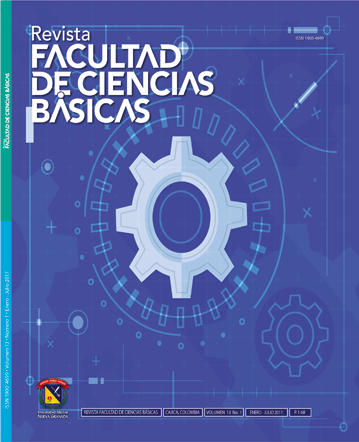Influencia de la fuerza de infección y la transmisión vertical en la malaria: modelado matemático
Resumen
Dos factores relevantes en la dinámica de transmisión de enfermedades infecciosas son la velocidad con la cual los individuos adquieren la enfermedad, y la transmisión vertical. En epidemiología el primer factor recibe el nombre de fuerza de infección. Este hecho ha motivado el modelado matemático que considere estos factores, sin embargo no siempre se consideran simultáneamente. En este trabajo, se formula y analiza un modelo matemático aplicado a la enfermedad de malaria, en el cual se incorporan ambos factores de forma simultánea. Por otro lado, para la población de mosquitos, además de la fuerza de infección clásica, se introduce una fuerza de infección que depende de la población total de mosquitos.
Descargas
Referencias bibliográficas
• Arino J, Ducrot A y Zongo P. 2012. A metapopulation model for malaria with transmissionblocking partial immunity in hosts. Journal of mathematical biology, 64(3), 423-448.
• Auger P, Kouokam E, Sallet G, Tchuente, M y Tsanou B. 2008. The Ross-Macdonald model in a patchy environment. Mathematical biosciences, 216(2), 123-131.
• Basáñez Gloria-María y Rodríguez Diego. 2004. Dinámica de transmisión y modelos matemáticos en enfermedades transmitidas por vectores. Entomotropica, 19(3), 113-134.
• Beaumont M, Zhang W y Balding D. 2002. Approximate Bayesian computation in population genetics. Genetics, 162(4), 2025-2035.
• Chitnis N. 2005. Using mathematical models in controlling the spread of malaria. In Partial Fulfillment of the Requirements For the Degree of Doctor OF Philosophy In the Graduate College. University of Arizona.
• Chitnis N, Cushing M y Hyman J. 2006. Bifurcation analysis of a mathematical model for malaria transmission. Society for Industrial and Applied Mathematics. 67(1),24-45.
• Chitnis N, Hyman J y Cushing M. 2008. Determining Important Parameters in the Spread of Malaria Through the Sensitivity Analysis of a Mathematical Model. Bulletin of Mathematical Biology, 70(5), 1272-1296.
• Cosner C, Beier J, Cantrell R, Impoinvil D, Kapitanski L, Potts M, Troyo A y Ruan S. 2009. The effects of human movement on the persistence of vector-borne diseases. Journal of theoretical biology, 258(4), 550-560.
• Die C y Hasibeder G. 1986. Population dynamics of mosquito-borne disease: effects of flies which bite some people more frequently than others. Trans. R. Soc. Trop. Med. Hyg, 80 (1), 69-77.
• Dietz K, Molineaux L, Thomas A. 1974. A malaria model tested in the African savannah. Bull World Health Organ, 50(3-4), 347-357.
• Driessche P y Watmough J. 2002. Reproduction numbers and sub-threshold endemic equilibria for compartmental models of disease transmission. Math. Biosciences, 180, 29-48.
• Esteva L y Yang H. 2005. Mathematical model to assess the control of Aedes aegypti mosquitoes by the sterile insect technique. Mathematical biosciences, 198(2), 132-147.
• Ibargüen-Mondragón E, Esteva L y Chávez-Galán L. 2011. A mathematical model for cellular immunology of tuberculosis. J. Mathematical Eiosciences and Engineering, 8(4), 976-986.
• Fonseca J y Maestre A. 2009. Incidencia de las malarias gestacional, congénita y placentaria en Urabá (Antioquia, Colombia), 2005-2007. Revista colombiana de obstetricia y ginecología, 60(1), 19-33.
• Gao D y Ruan S. 2012. A multipatch malaria model with logistic growth populations. SIAM journal on applied mathematics, 72(3), 819-841.
• Hasibeder G y Dye C. 1998. Population dynamics of mosquito-borne disease: persistence in a completely heterogeneous environments. Theoretical population biology, 33(1), 31-53.
• Macdonald G. 1957. The epidemiology and control of malaria. Oxford University, Press, London.
• Mandal S, Sarkar R y Sinha S. 2011. Mathematical models of malaria-a review. Malaria Journal, 10(1), 1.
• Mueller I, Schoepflin S, Smith TA, Benton KL, Bretscher MT, Lin E, Kiniboro B, Zimmerman PA, Speed TP, Siba P y Felger I. Force of infection is key to understanding the epidemiology of Plasmodium falciparum malaria in Papua New Guinean children. Proceedings of the National Academy of Sciences, 109(25), 10030-10035.
• Muench H. 1934. Derivation of rates from summation data by the catalytic curve. Journal of the American statistical association, 29(185), 25-38.
• Ngwa G and Shu W. 2000. A Mathematical Model for Endemic Malaria with Variable Human and Mosquito Populations. Mathematical and Computer Modeling, 32 (7), 747-763.
• Perko L. 1991. Differential Equations and Dynamical Systems. Springer-Verlag, New York, First Edition.
• Rainey J, Mwanda W. O, Wairiumu P, Moormann A, Wilson M y Rochford R. 2007. Spatial distribution of Burkitt´s lymphoma in Kenya and association with malaria risk. Tropical Medicine and International Health, 12(8), 936-943.
• Rodríguez D y Torres-Sorando L. 2001. Models of infectious diseases in spatially heterogeneous environments. Bulletin of Mathematical Biology, 63(3), 547-571.
• Roll Back malaria. The global partnership for a malaria-free world. Disponible en http://www.rbm.who.int/ProgressImpactSeries/report2.html. Consultado en enero 2014.
• Ross R. 1911. The prevention of malaria. John Murray, London.
• Smith D, Dushoff J y McKenzie F. 2004. The risk of a mosquito-borne infection in a heterogeneous environment. PLoS Biol, 2(11), 1957-1964.
• Sobrebón J, Cocho G, Aldama A, Falconi M, Esteva L y Lara M. 2002. Clásicos de la Biología Matemática. Siglo XXI editores, s.a de c.v. Cerro del agua 248. Delegación Coyoacán, 04310, México D.F. Primera edición.
• Tchuenche J, Chiyaka C, Chan D y Mayer G. A mathematical model for antimalarial drug resistance. 2011. Mathematical Medicine and Biology, 28 (24), 335-355.
• Torres-Sorando, L y Rodríguez D. 1997. Models of spatio-temporal dynamics in malaria. Ecological Modelling, 104(2), 231-240.












